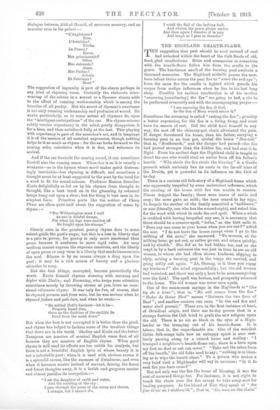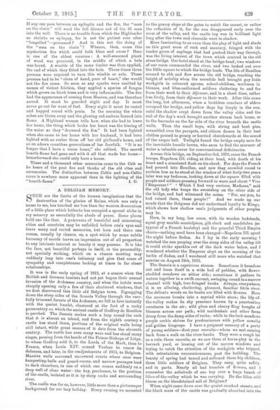THE HIGHLAND HEARTH-FLAME.
THE suggestion that peat should be used instead of coal • had unlocked within the heart of the Celt fiooda of old, fond, glad recollections. Rites and ceremonies in connexion with the hearth-flame follow him from the cradle to the grave. The heartsoine smell of the burning peat awakens a thousand memories, The Highland midwife pnases the new- born infant thrice across the peat fire to "avert the evil eye "; from the same fire the candle is lighted which guards his corpse from malign influences when he lies in his last long sleep. Possibly his earliest recollection is of his mother " smooring [smothering] the fire" ere going to bed, a rite to be performed reverently and with the accompanying prayer :— "I am smooring the fire, 0 God, As the Son of Mary would smoor it."
Sometimes the ceremony is called "resting the tire"; possibly a better expression, for the fire is a living thing, and must have its season of rest. Did the child hurt himself in any way, the soot off the chimney-pot chain alleviated the pain. If danger threatened his home. then his father, carrying a burning peat in an iron pot, circled the house " Dea-soil," that is, " Southwards," and the danger had passed—the fire had proved stronger than the hidden foe, and had sent it to flight. From his earliest days the Highland child is taught to dread the one who would steal an ember from off his father's hearth. "Who steals the fire steals the blessing" is a Gaelic proverb which certainly has its roots in the far-off time of the Druids, yet is powerful in its influence on the Celt of
to-day. -• There is a curious old folk-story of a Highland home which
was apparently bespelled by some malevolent influence, which the circling of the house with fire was unable to remove. Illness dogged the family; there were losses of cattle and crop; the cows gave no milk ; the hens ceased to lay eggs. In despair the mother of the family consulted a "taiblisear," or seer (literally, one who has the .second-sight), and asked him for the word with which to undo the evil spell. When a witch is credited with having bespelled any one, it is necessary that there should be a counter-spell, " brtha," as the Celt cans it. "Does any one come to your house when you are out P" asked the seer. "I do not leave the house except when I go to the milking of the cows," she answered. "To-morrow, at the milking hour, go not out, or rather go out, and return quickly, and by stealth." She did as ho had bidden her, and as she crept in by a back entrance she was just in time to see an old woman, to whom she had often shown kindness, slipping in slyly, seizing a burning peat in the tongs she carried, and going softly out again. " Ah, Shenag, is it thus you repay my kindness ?" she cried reproachfully; but the old woman had vanished, and there was only a hare to be seen scampering over the field The spell was broken, and prosperity returned to the home. The old woman was never seen again.
One of the commonest sayings in the Highlands is "Cisa gig olo a teine" ; that is, "No evil comes from the fire." " Eadar cla iheine Bhal" means "Between the two fires of Baal"; and another curious one runs, "In the end fire and water shall prevail." These are, in the first instance at least, of Druidical origin,, and their use to-day proves that in a strange fashion the Celt tried to graft the new religion upon the old. There is no sin so black in the eyes of a High- lander as the tramping out of his heertheilasue. It is taboo; that is, the unpardonable sin. One of the weirdest Celtic folk-songs tells how an unhappy spirit is ever rest-
lessly passing along by a ruined home and : "I tramped a 'neighbour's hearth-flame out; there is a burn upon my foot no dust or ash can cover." "Take not the ashes from off the hearth," the old folks used to say; "nothing is so blast- ing as to wipe the hearth clean." To a person who makes a. very brief vieit a Highlander will say in sarcasm: "Is it to seek fire you have come?" But not only was the fire the home of blessing, it was the
seat of accursed things too. For instance, it is not right to touch the chain over the fire except to take away soot for healing pnrposes. In the island of Uist they speak of "Am fear th'air an t-slabhruidh"" ; that is, "the man on the chain,"
If ally one pass between an epileptic and the fire, the "man on the chain" will send the fell disease out of the ill man into the well. There is no trouble from which the Highlander so shrinks as epilepsy, for is not the patient ever after " bespelled "—possessed ? And is this not the doing of the "man on the chain "? Whence, then, came this mysterious fire which could both bless and curse ? Here is one of the oldest versions : A well-seasoned plank of wood was procured, in the middle of which a bole was bored. A winible of the same timber was then applied, the end of which they fitted into the hole. Three times three persons were required to turn this wimble or axle, These persons bad to be "clean of hand, pure of heart," else would not the fire come. So soon as any sparks were emitted by means of violent friction, they applied a species of fungus which grows on birch trees and is very inflammable. The fire had the appearance of coming from HeaVen, and was therefore sacred. It must be guarded night and day. It must never go out for want of fuel. Every night it must be rested and happed round with peats. In the morning the white ashes are blown away and the glowing red embers fanned into flame. A Highland woman tells how, when she had to leave her home, the thing which broke her heart was the hissing of the water as they "drowned the fire." It bad been lighted when she came to her home with her husband, it had been lighted with an ember from off her old girlhood's home, and so on adown countless generations of her forefolk. "It is no longer that I have a warm home," she sobbed. The sacred hearth-flame had gone and with it all that made her home— henceforward she could only have a house, These and a thousand other memories come to the Celt as be hears of the peat fire and thinks of the old rites and ceremonies. The distinction between Celtic and non-Celtic races is nowhere more apparent than in the lighting of the















































 Previous page
Previous page